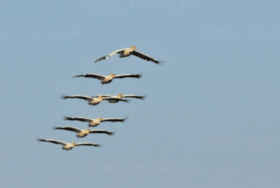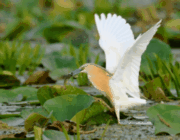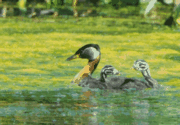|
Mike Mockler Spain & Romania |
Europe - Spring 2015 RETURN TO SPAIN AND ROMANIA Spain, early March 2015 Last year’s attempts to capture Lammergeier on camera had really whetted my appetite and the chance of a second attempt was irresistible. I felt there was still more in this spectacular bird’s behaviour to be captured on camera so I arranged further sessions in “Lammergeier country” in the foothills of the Pyrenees as winter was drawing to a close. Even if I failed to obtain the perfect photograph (which always remains just out of reach), I hoped to have close views of these beautiful birds. As usual, European Griffon Vultures were by far the most common vulture species I saw but several eyeball-to-eyeball encounters with Lammergeiers were truly breathtaking. Lammergeiers are elegant and impressive in flight, effortlessly gliding and soaring on long, stiff wings but, at ultra-close range when you can see the colours of their cream-gold plumage and the drooping moustache that gives the species its alternative name of Bearded Vulture, they are absolutely spellbinding. Other species presented themselves as photographic subjects too but it was not the best time of the year for bird photography as the spring migration had barely begun and opportunities were limited. Despite that, I enjoyed some success, notably with a very obliging Kingfisher and two Goshawks. Romania: The Black Sea Coast & the Danube Delta, May/June 2015 Eastern Romania, however, turned out to be very different. It is far less scenic than Transylvania, with flat, intensively-farmed agricultural land displaying evidence of heavy use of pesticides. Also, Romania’s reputation for having major problems with waste-disposal seems justified; in many places there were huge accumulations of plastic bags and bottles, scrap metal and quantities of broken glass on an epic scale. Britain’s countryside is bad enough where litter and fly-tipping are concerned but what I saw in some parts of eastern Romania was far worse. Also, parts of what should be a pleasant, rural countryside are disfigured by many large quarries, massive abandoned factories and disused power-stations that have been left to decay and disintegrate – ugly reminders of the Soviet era. Some villages are in a sad state: crumbling and boarded-up houses and an absence of young people tell of migration to the cities and the resulting slow decline of rural communities. All very different from what I had seen in Transylvania a year before. Happily, away from areas of intensive agriculture, there are attractive hills, cloaked in forest, that still support varied wildlife: Roller, Bee-eater, Cuckoo, Golden Oriole, Red-footed Falcon, Hobby, Long-legged Buzzard and Lesser Spotted Eagle to name a few birds. Some of the birds I was able to photograph included Marsh Harrier, Isabelline Wheatear, Hoopoe, (Rufous-tailed) Rock Thrush, Hawfinch, Red-backed Shrike, Woodlark, Ortolan Bunting, Stone Curlew, Collared Pratincole and Turtle Dove. The latter are very common in Romania and it was such a joy to hear their soporific, purring song, a sound that is now only a distant memory for most British people, thanks to our modern “efficient” farming methods. Also, a Barred Warbler collecting spiders’ webs as nest material provided a rare opportunity to photograph this skulking species for the first time. Red Fox, Common Jackal (a fleeting glimpse) and Roe Deer were the only large mammals we saw but Susliks, endearing little ground squirrels that live in open grasslands, were charming photographic subjects. Wolves, Brown Bears and Lynx are confined to the Carpathian Mountains. The high point of this Romanian trip, unsurprisingly, was the Danube Delta. The Delta’s wildlife importance is well-known and its natural treasures need no introduction here. Sadly, the main channel of the Danube in its last leg to the Black Sea is an unattractive canal, its banks piled up with stones and boulders where huge numbers of tin cans and plastic bottles are snagged among the rocks. Fortunately, elsewhere in the Delta are idyllic places hidden among its secluded waterways: shallow bays, forested islands, reed-beds and hidden lagoons where calm waters are carpeted with water-lilies teeming with nesting grebes and terns. Inevitably, water-birds take centre stage in this vast watery wilderness: Pygmy Cormorant, Dalmatian Pelican (both globally threatened), White Pelican, Caspian Gull, Whiskered Tern, Black Tern, Great Crested Grebe, Red-necked Grebe and Black-necked Grebe as well as a wide range of herons and egrets. These included (Black-crowned) Night Heron, Purple Heron, with its rich, warm colours, and the dapper little Squacco Heron, its lovely butterscotch and vanilla plumage perfectly finished off with elegant plumes down the back of its neck. Ferruginous Duck and Pochard were among the ducks we saw, while many songbirds sang in the reed beds and woodlands. Great Reed Warblers were the most audible of these, perching prominently on tall reed stems to belt out their powerful, grating song. In the more tranquil lagoons, the surface of the water was dotted with many hundreds of frogs. The males called incessantly, puffing out the vocal sacs on the sides of their necks like miniature balloons of bubblegum. Many fell victim to the herons but European Edible Frogs were the target of another predator, the local frog-fisherman. Sitting all day in a small rowing boat, looking for all the world like a garden gnome, he used traditional skills that have been passed down through generations. Tapping the surface of the water with a fishing rod to lure the frogs closer, he scooped his victims up with what looked like a child's fishing net in his other hand. I came away from the Danube Delta with some pleasant memories: lines of pelicans etched against the dawn sky; the ever-present “booming” of Bitterns hidden deep in the reed-beds, a massive White-tailed Eagle circling overhead; a swirling blizzard of terns over their nest-colonies when disturbed by a passing Marsh Harrier and grebe parents cruising through lily-pads with humbug-striped chicks on their backs. Birdlife is still prolific in the Delta but there is cause for concern about pollution carried downstream in the Danube and ecological changes, as reported by the International Commission for the Protection of the Danube River. Also, part of the Delta is within Ukraine and war-torn Donetsk is a very short distance away.
|
|
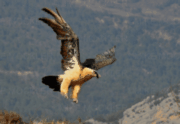
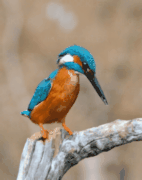
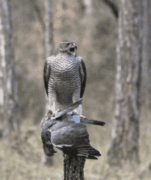
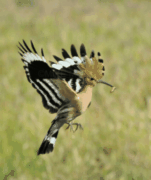
 rock thrush.gif)
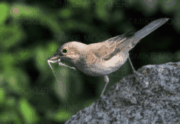
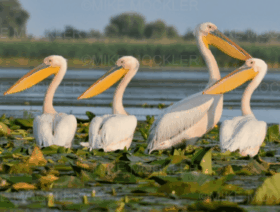

.gif)
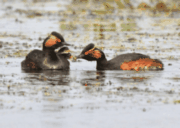
.gif)
